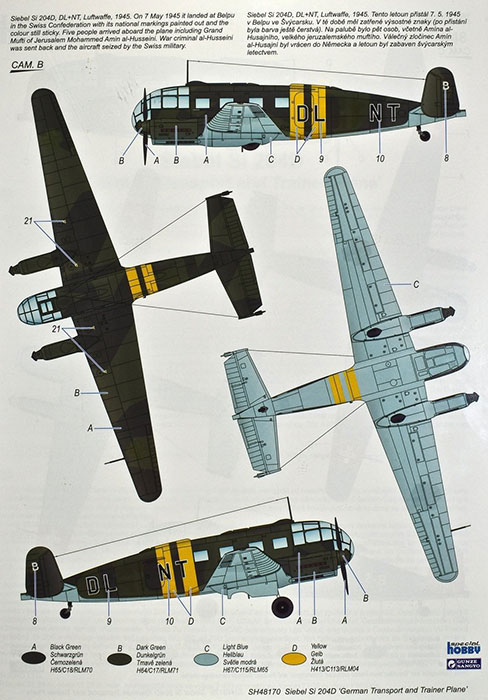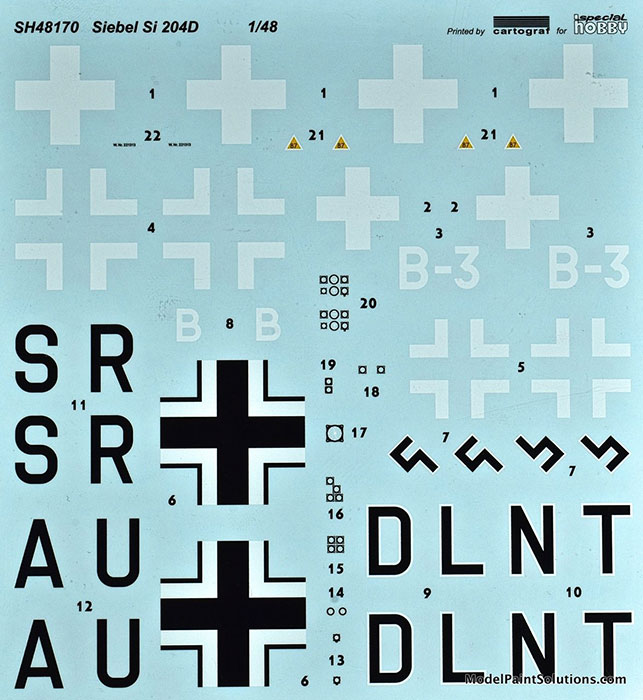Siebel Si 204 D
German Transport and Trainer Plane

Special Hobby, 1/48 scale
S
u m m a r y : |
Description and Item No.: |
Special Hobby Kit No. 48170 - Siebel Si 204 D German Transport and Trainer Plane |
Contents and Media: |
144 parts in grey styrene,13 in clear, one part in resin, and one decal sheet with airframe stencils and three marking options. |
Price: |
49,90 € Plus Shipping from Special Hobby's website
GBP£44.99 EU Price (£37.49 Export Price) Plus Shipping at Hannants |
Scale: |
1/48 |
Review Type: |
First Look |
Advantages: |
High level of detail; scale-appropriate recessed surface detail; conventional parts breakdown. |
Disadvantages: |
None noted. |
Recommendation: |
This is going to be an eye-catching kit when complete. In addition to having a pretty respectable wing span, the large, crystal clear windscreen will invite inspection of the wealth of detail therein. The parts layout is simple and and the kits engineering is conventional making for a pretty straightforward build. I see no apparent issues laying in wait other than a lot of fun building and painting time. |
Reviewed by John Miller

The Siebel Si 204 was a small twin-engined transport and trainer aircraft developed by Germany during World War II. Based on the Fh 104 it was originally designed in response to a 1938 RLM development order for a small civil transport aircraft but was was eventually produced for the Luftwaffe.
The first two prototypes were delivered as passenger aircraft. After the beginning of the war, the aircraft was redesigned as a trainer aircraft with a full "stepless" glass cockpit, as had been initiated with the He 111P in early 1938. With no separate, flat windscreen for the pilot (as most German bombers of the time were being designed), the Si 204 seemed suited for blind flying training.

The Si 204D was used mainly in B- and C-Training Schools (advanced schools) and in FÜG 1 (delivery wing of the Luftwaffe). Its service with FÜG 1 was probably as a taxi aircraft for crews delivering aircraft to fighting units. Its use in blind flying schools was sporadic and no evidence the type was used by radio schools has been published. In addition to training schools, the Si 204 flew mainly with communications squadrons and flying services for senior officers.
Interestingly, a Si 204 was likely the last German aircraft to be shot down on the Western Front. This occurred on May 8, 1945 when P-38 pilot 2nd Lt. K. L. Smith, of the 9th Air Force's 474th Fighter Group, downed a Siebel 204 3 miles southeast of Rodach, Bavaria.
At the end of WWII, captured Si 204s flew in a variety of civil roles in multiple counties including Russia, Czechoslovakia, and Switzerland.
Edited from Wikipedia
I have to say up front that I’m a huge fan of Special Hobby kits and have been for many years.
I have followed along as the companies’ first, somewhat crude, offerings paved the way for a long list of kits of ever-increasing quality and detail. The cornerstone of this company is the production of quality kits of lesser-known but often historically significant aircraft. And, so it is with this offering, the Siebel Si 204D; an interesting aircraft that borders on having a pleasing shape—almost, but not quite. As with all current Special Hobby (SH) kits this is a somewhat limited production kit. I say “somewhat” in that a little extra effort will be required to deal with flash and parts clean up. In addition, some parts require modification (shortening for example) prior to being used and this will add to the work load. That said I doubt there’s anything that can’t be dealt with by a little experience or patience.
In the Box
As is the norm with SH kits, the surface details are very nice and scale appropriate. The recessed panel lines are crisply rendered with sufficient depth to easily take a wash after painting. Parts layout and engineering are conventional suggesting this will be a straightforward build.
Assembly begins with the cockpit (imagine that) wherein there’s a lot of detail provided right out of the box. Good thing too as that large “stepless” windscreen combined with the multiple, large cabin windows will permit a lot of the cockpit and cabin details to be seen when the model is completed.
Of note are the nicely moulded cockpit side panels and rudder pedal assemblies. The pilot and co-pilot seats are nicely detailed along with their substantial mounting structures and dual arm rests. The well moulded, Y-shaped yokes and detailed bulkhead, complete with curtain, will look very convincing under paint and a wash.
Behind the flight deck is the radio operator’s position complete with nicely moulded radio gear and fold-down work desk. Behind this is a prominent rack of oxygen bottles and three passenger seats arranged in tandem on the port side of the cabin. The passenger seats have nicely rendered fabric back supports that wrap around tube frames. All of these very nice details are going to look amazing when viewed through the large windscreen; nicely done, Special Hobby.
Once the fuselage windows are installed and the cockpit /cabin assembly is trapped between the fuselage halves, the builder is directed to affix the two-part front windscreen, which, as with all the other clear parts, is crystal clear with scale appropriate framing.

The wings and engine nacelle assemblies are simple and straightforward utilizing a minimum of parts. Per side, 6 parts comprise the wing and wheel well while only 8 comprise the engine, exhausts, and nacelle: very nice.

With the wings joined to the fuselage, the builder is directed to assemble the halved horizontal stabilizers/elevators followed by the halved vertical stabilizers/rudders. Once these are glued in place the airframe is largely complete.
The multi-part gear legs and actuators are crisply moulded and nicely detailed as are the main wheels/tires that are, unfortunately, comprised of halves.
The DF football is supplied as a resin part.

With the addition of the nicely moulded, two-bladed props, an aerial, and rigging, the model is complete. Of note, separately moulded cabin doors are provided for each side of the fuselage allowing the cabin to posed open; very nice, indeed :)
Markings:
The decals, by Special Hobby, are well printed with good registration and color density.

Airframe stencil data and markings for three airframes are provided as follows:
-
Siebel Si 204 D W.Nr. 221313, SR + AU, Flugzeugführerschule (FFS) C15, Luftwaffe, Bourges, occupied France, 1943.
-
Siebel Si 204 D, DL + NT, Luftwaffe, 1945. Carried war criminal Grand Mufti of Jerusalem Mohamed Amin al-Husseini to Belpu in the Swiss Confederation. Amin al-Husseini was sent back and the aircraft seized by the Swiss military.
-
Siebel Si 204 D, B3 (ex DL + NT), Swiss Air Force, Dübendorf, Switzerland, 1945-1955.
This is going to be an eye-catching kit when complete. In addition to having a pretty respectable wing span, the large, crystal clear windscreen will invite inspection of the wealth of detail therein. The parts layout is simple and and the kits engineering is conventional making for a pretty straightforward build. I see no apparent issues laying in wait other than a lot of fun building and painting time.
For more on this review visit Modelpaintsolutions.com.
Review kit provided by my retirement fund, again.
Review Text and Images Copyright © 2020 by John Miller
Page Created 4 December, 2020
Last updated
4 December, 2020
Back to HyperScale Main Page
Back to Reviews Page

|
Home
| What's New |
Features |
Gallery |
Reviews |
Reference |
Forum |
Search